Creating DIY sensory toys at home is one of the most meaningful, affordable, and scientifically-backed ways to support your baby’s brain development — and to create joyful bonding moments every single day.
In today’s world, where toy stores are filled with plastic gadgets, flashy lights, and branded sets like the Barbie Dream House, many Indian parents feel overwhelmed. The pressure to “buy the best” can overshadow what truly matters: simple, sensory-rich experiences that spark learning and love.
But here’s the good news — you don’t need expensive toys to give your baby the best start. With a few everyday items like cloth, spoons, boxes, and bells, you can create a sensory playground right at home.
Why Sensory Play Matters from Day One
From the moment your baby is born, they begin exploring the world through their senses — sight, sound, touch, taste, and smell. Every giggle, every curious touch, every new sound is your baby’s way of learning. Sensory toys help your baby:
- Strengthen motor skills (grabbing, crawling, shaking)
- Develop brain connections through exploration
- Learn cause-and-effect by interacting with textures, shapes, and sounds
- Build emotional bonding through responsive, shared play with caregivers
That’s why DIY sensory toys play a crucial role in your child’s early months. These handcrafted gems are instruments for developing the brain, not just toys.
Backed by Science: What Studies Say
Primary sensory interactions influence a child’s brain design, according to Harvard University’s Center on the Developing Child. The more your baby touches, sees, and hears new things, the more their brain “wires” itself for learning.
🧠 For example:
- A soft cloth made from an old saree provides tactile stimulation
- A mirror toy helps babies with self-recognition
- Crinkly paper introduces auditory learning
These aren’t just cute activities — they’re part of a scientific strategy for healthy brain development.
📘 External Reference:
Harvard University-department center for studies on the Developing Child
Why Choose DIY sensory toys Over Branded Toys?
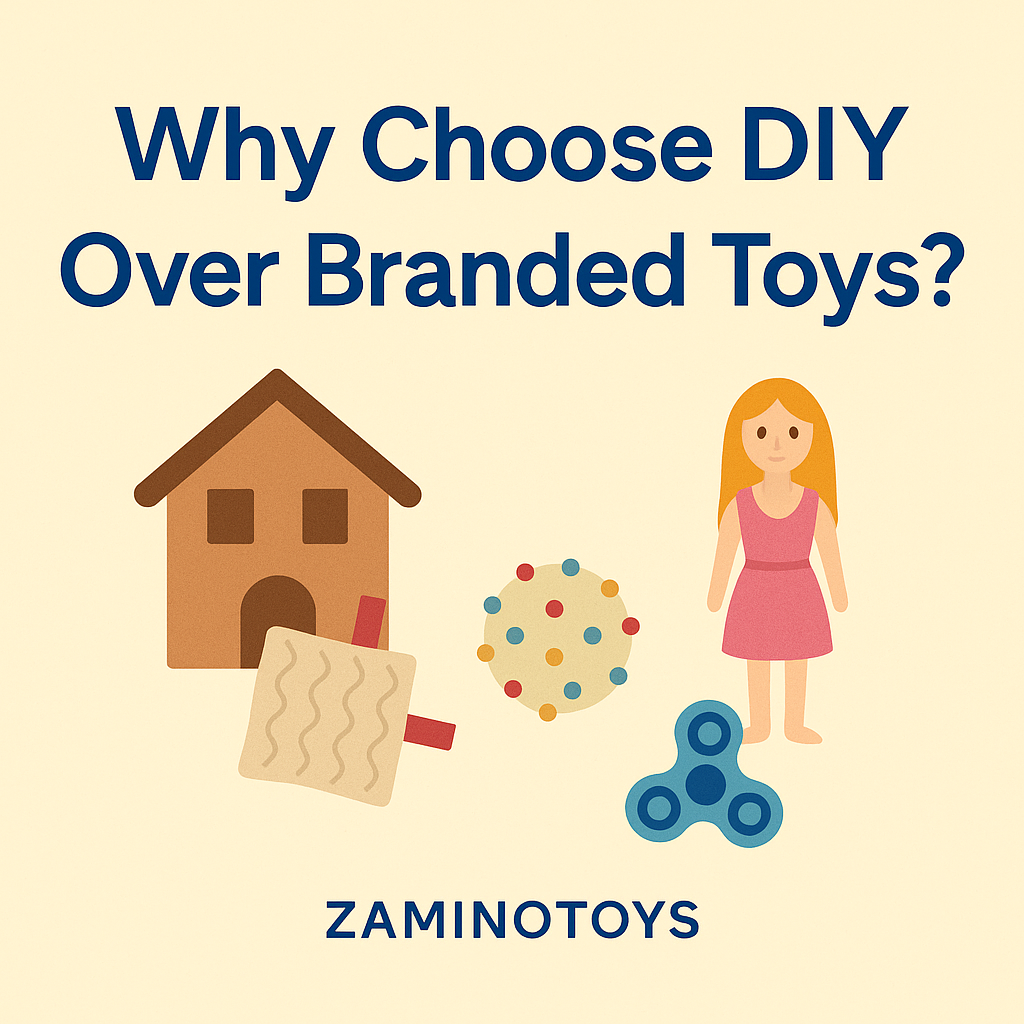
Let’s be honest — branded toys like the Barbie Dream House, fidget toy adult kits, or plastic doll house toys may look exciting. But most of them are:
- Overstimulating for babies under 1 year
- Expensive, with limited long-term use
- Designed for entertainment, not always for development
Meanwhile, DIY sensory toys offer:
✅ Open-ended play (babies explore at their pace)
✅ Customization (you know your baby’s needs)
✅ Budget-friendly fun
✅ Better emotional bonding (since you made it together or for them)
✅ Alignment with Montessori principles (natural, simple, purposeful)
🌟 Bonus Insight:
Sensory toys like play mat sensory boards or children’s doll house play zones can easily be made at home. A cardboard box becomes a doll house dreamland when you add fabric textures, shiny foil, and peek-a-boo flaps. And a few ribbons stitched to an old dupatta create a stimulating visual toy for newborns.
🔗 Related Blog Post
Toys for 0–6 Months: Sensory & Brain Development Guide
🧠 The Science Behind DIY Sensory Toys
DIY sensory toys aren’t just about fun — they’re tiny tools that help build your baby’s brain, body, and bond with you. Every time your child touches, shakes, or explores a homemade toy, their brain lights up with learning!
Let’s break it down:
1. 🧩 Cognitive Development
When babies explore different textures, colors, or movements, they’re learning to solve problems and recognize patterns.
- Example: A DIY sensory toys as a kind of cloth made with old sarees, felt, and foil introduces babies to contrast, texture, and cause-and-effect.
- What It Builds: Pattern recognition, memory, and visual processing.
🧠 Scientific Insight: According to the Journal of Developmental & Behavioral Pediatrics, sensory-rich play in infancy strengthens attention span and reduces anxiety in later years.
2. 👐 Motor Skills
Whether it’s grabbing a ribbon, crawling through a DIY doll house tunnel , (example for DIY sensory toys) or dropping a soft toy into a box, your baby’s muscles are getting a workout.
- Gross Motor Skills: Crawling, rolling, reaching, pulling
- Fine Motor Skills: Pincer grasp, object transfer, finger control
DIY sensory toys for babies like fabric pull boxes or textured shape sorters support coordination while allowing natural exploration.
🧸 Tip For Parents: To promote movements, place toys simply out of reach.
3. 🗣️ Language & Social Skills
Babies don’t just learn to talk by hearing words. They learn through sensation and interaction. When you respond to their curiosity during play, you’re building trust and early communication.
- Examples of DIY sensory toys That Encourage Language:
- Talking about how something feels: “This is rough! That’s soft.”
- Repeating sounds your baby makes with toys
- Using peek-a-boo dolls or mirrors for social-emotional learning
💬 Did You Know? Studies show that responsive parenting — reacting to a child’s interest with warmth and language — leads to better language outcomes in toddlers.
Why DIY Matters
Unlike battery-operated toys, DIY sensory toys are:
- Open-ended (allowing repeated, creative play)
- Custom-made for your baby’s needs and pace
- Less overwhelming — supporting focused, calm learning
And most importantly, they are designed by YOU — the person your baby loves the most. That connection makes every DIY toy a memory in the making.
🔗 Related Reads on ZaminoToys:
📘 External Reference:
Journal of Developmental & Behavioral Pediatrics – “The Impact of Early Sensory Experiences on Emotional Regulation and Attention Outcomes”
🧵 Safe DIY Materials You Can Find at Home
Creating DIY sensory toys at home doesn’t require fancy craft kits or expensive materials. In fact, your home is full of baby-safe items that can turn into brilliant learning tools — as long as you use them wisely and with love.
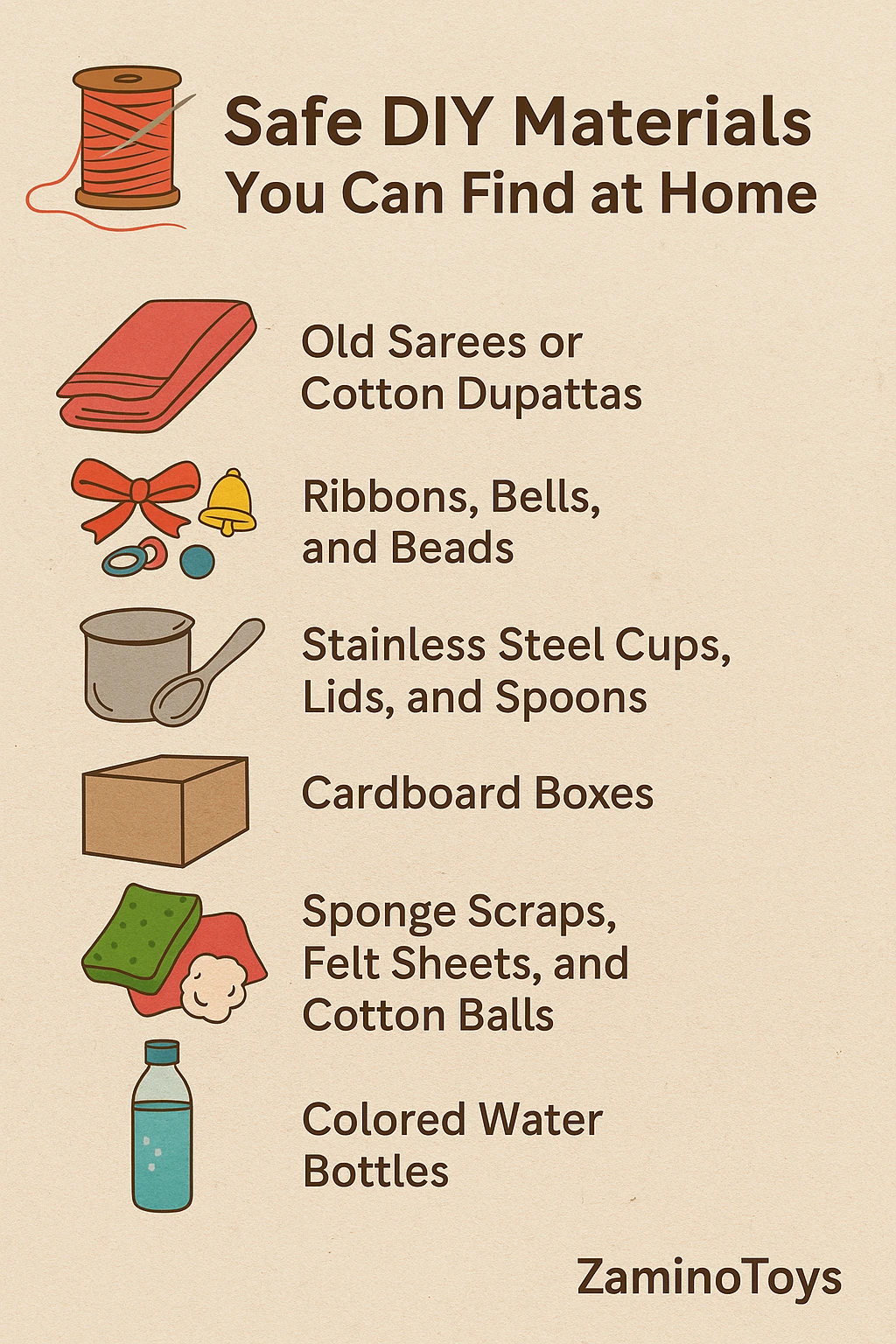
Here’s a list of safe and sensory-rich materials that Indian parents can easily find in every household:
1. 👗 Old Sarees or Cotton Dupattas
Repurpose soft, worn-out fabrics to make crinkle cloths, peek-a-boo covers, or DIY plushies. The gentle texture is perfect for babies, and familiar fabrics can even offer comfort through smell and softness.
✅ Make a surprise toy by stitching foil on a soft cotton square.
2. 🎀 Ribbons, Bells & Beads (With Safety First!)
These small accessories can add magic to your doll house or sensory board. Use bells for sound, ribbons for touch, and large stitched beads for visual interest. Just make sure they are tightly stitched and cannot be pulled off by little hands.
❗ Safety Tip: Avoid small beads for babies under 9 months. Always supervise.
3. 🥄 Stainless Steel Cups, Lids, and Spoons
Who knew your kitchen held such amazing toys? Metal utensils are excellent for sound-based play and safe for mouthing once cleaned properly.
✅ Sensory Tip: Let babies bang spoons together or explore lid puzzles.
4. 📦 Cardboard Boxes
Whether you want to make a DIY doll house, a pull-toy, or a crawling tunnel — cardboard is your best friend. It’s free, flexible, and eco-friendly.
🧸 Popular Use: Design a two-room doll house with textured “walls” for older babies to crawl into or explore with their fingers.
5. 🧽 Sponge Scraps, Felt Sheets & Cotton Balls
These soft materials are ideal for touch-based sensory toys.Stitch felt creatures together to create a do-it-yourself plush toy, or fill a prize basket with sponge strips. if Done properly cotton balls imitates like clouded in a doll house (when pretend playing)
✅ Idea: Create a soft sensory board using felt patches and cotton textures.
6. 💧 Colored Water Bottles
Fill baby-safe bottles with colored water, glitter, or small floating toys (always sealed tight). These bottles are excellent for visual play and early science learning.
🌈 Bonus: Use a flashlight to turn them into a light show!
⚠️ Safety First: Never Compromise
No matter how exciting the toy looks, safety is always the priority.
- ✅ Avoid using everything small as a 2-rupee coin due to risk of choking.
- ✅ Wash fabrics before use
- ✅ Never leave your baby unattended during DIY play
- ✅ Store toys in breathable cloth bags (avoid plastic)
💡 ZaminoToys Tip: Simple homemade toys can do wonders for your baby’s development — and for your bond as a parent. You do not require a Barbie doll house or an expensive fidget toy adult bundle to make magic. All you need is curiosity, care, and creativity.
🔗 Explore More:
🎯 Month-by-Month Sensory Toy Guide (0–12 Months)
Babies learn through play — especially sensory play. That’s why choosing age-appropriate toys makes a huge difference in your child’s development. This month-wise sensory toy guide blends science-backed milestones with simple, home-based toy ideas.
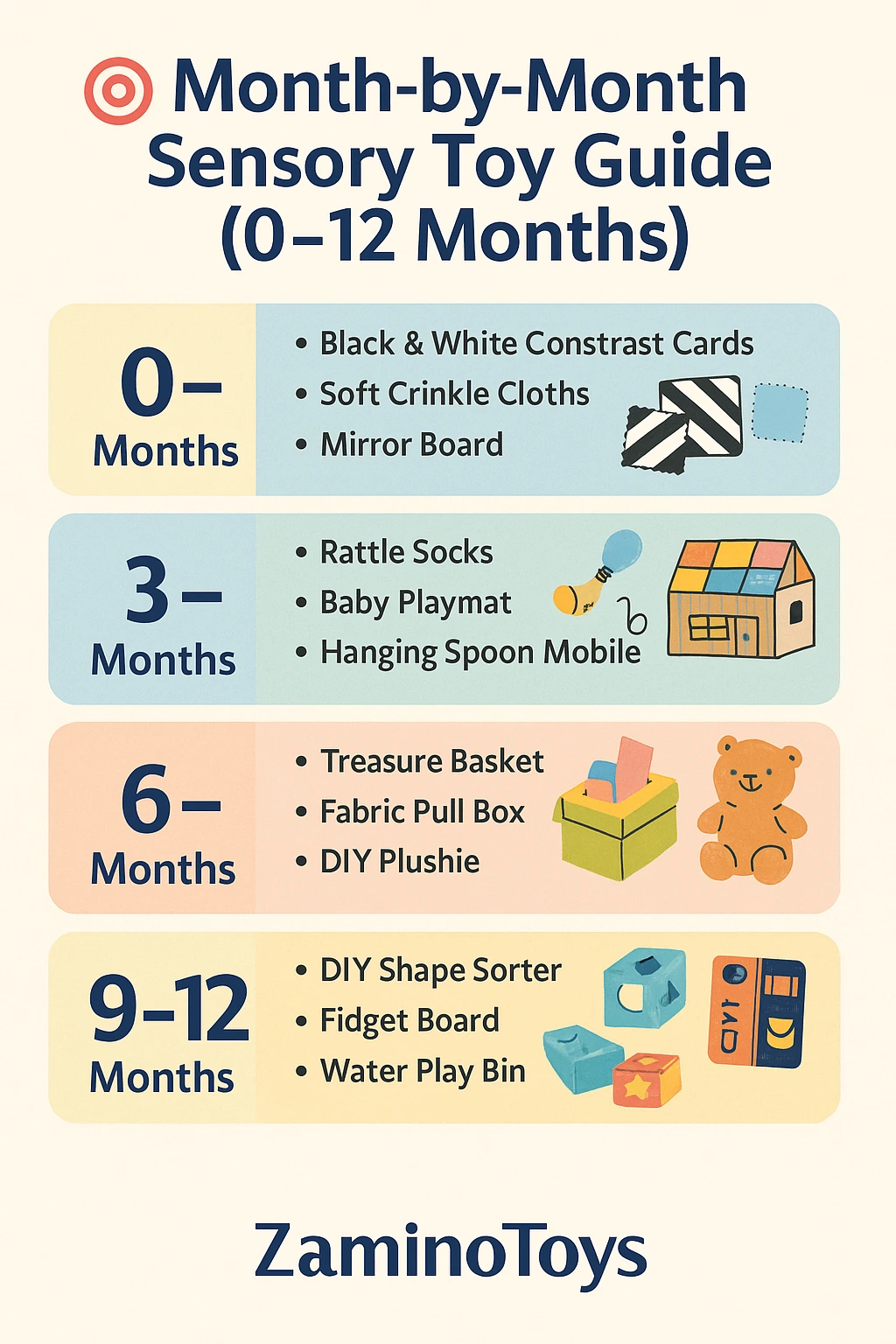
All suggestions focus on DIY sensory toys, safe materials, and development goals. And yes — they include fun ideas like sensory doll houses and fidget toys that parents can enjoy too.
📅 0–3 Months: Calm & High Contrast
At this stage, babies are just adjusting to the world. Their vision is fuzzy, and their actions are primarily reflexes. Your goal? Stimulate gently.
✅ Try These DIY Sensory Toys:
- Black & White Contrast Cards
Babies love bold, simple visuals. Print or design high-contrast patterns, then stick it to the crib. - Soft Crinkle Cloths
Use old sarees or cotton fabric with foil inside to create a sound they can explore. - Mirror Boards
Babies are fascinated by faces. Install mirror(must be baby safe) in a box (customize it as a doll house shape ) like frame for catchy appeal
🔗 Related Post: Best Toys for 6 to 12 Months
📅 3–6 Months: Reach, Grab & Discover
Your baby is now reaching for objects and beginning to explore textures. It’s the perfect time for movement-based play.
✅ Toy Ideas That Stimulate Senses:
- Rattle Socks
Sew tiny bells into baby socks to encourage kicking and leg movement with a soft sound. - DIY Sensory Play Mat
Stitch patches of different textures onto a cloth or use a play mat sensory quilt made from recycled fabrics. - Hanging Spoon Mobile
Tie colorful kitchen tools like plastic spoons and ladles to a hanger — it becomes a musical and visual mobile! - Mini Doll House Room
Use a small cardboard box to create a soft room with textured fabric. Let baby feel the “walls” of their first DIY doll house!
💡 Pro Tip: Choose calming colors and baby-safe materials. This isn’t about perfection — it’s about sensory connection.
📅 6–9 Months: Sitting, Crawling & Tasting!
Your little one is on the move now! Their hands are busy, and their mouth is the primary exploration tool. Choose toys that are easy to mouth, grip, and manipulate.
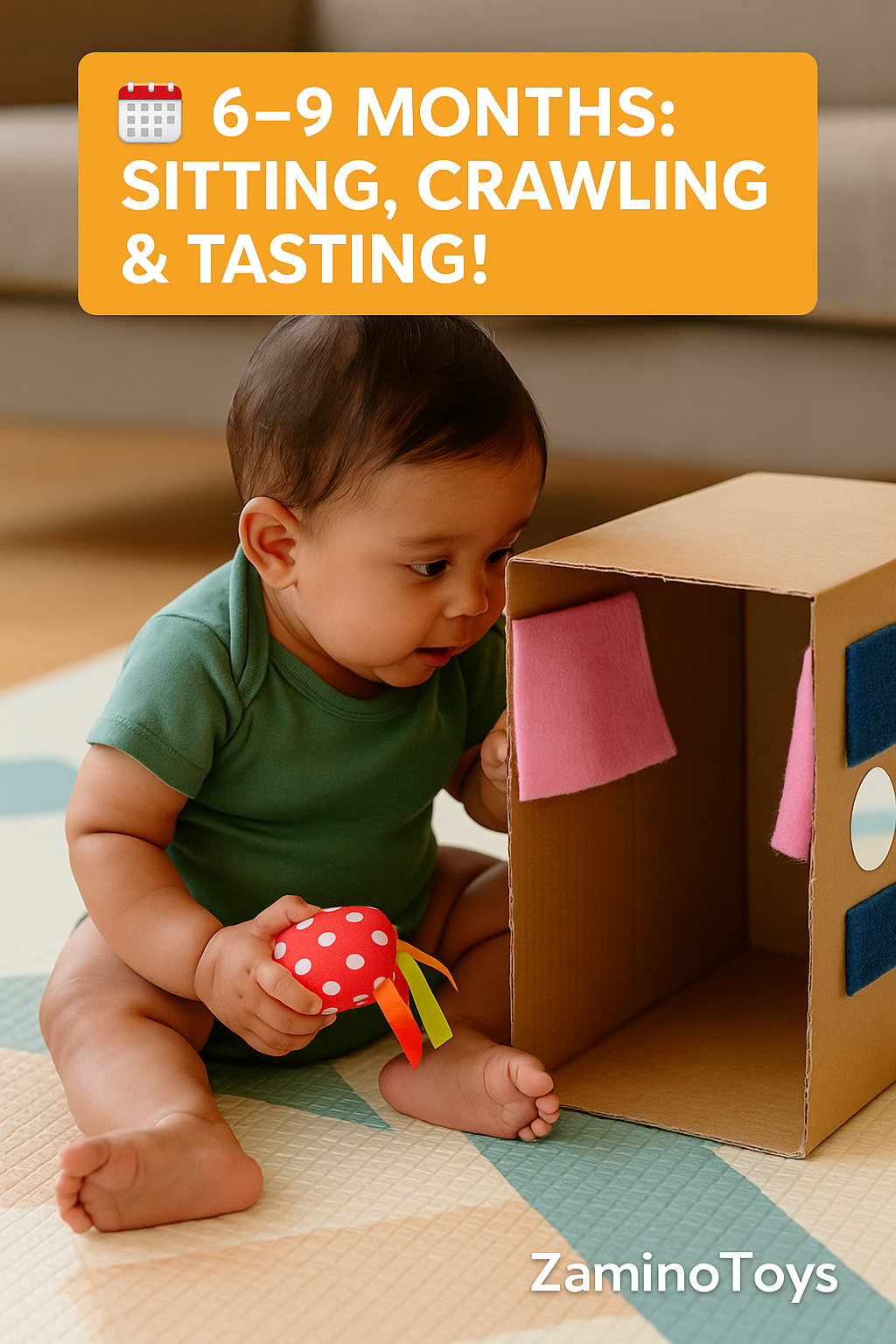
✅ DIY Sensory Toy Ideas for This Stage:
- Treasure Basket
Fill a basket with everyday safe items: a wooden spoon, a soft brush, a metal measuring cup, a loofah. Always supervise! - Fabric Pull Box
Repurpose an empty tissue box by stuffing it with ribbons, cloth scraps, or old ties. - Homemade Plushie Toys
Stitch simple animals or shapes from felt. Add texture with fabric paint or buttons (only for 10+ months under supervision). - Crawl-Through Doll House Tunnel
Turn a large cardboard box into a doll house tunnel. Cut windows and doors, add fabric inside, and let them crawl through a sensory adventure!
📘 Bonus Read: Toys – What, When & Why? A Complete Guide
📅 9–12 Months: Cause & Effect Fun
Welcome to the “I-drop-everything” phase. Babies now understand that their actions have outcomes. This is the best time for Montessori toys and hands-on sensory experiments.
✅ Must-Try Sensory Toys:
- DIY Shape Sorter
Cut holes into a shoebox lid. Let your baby sort bottle caps or plastic lids. - Fidget Sensory Board
Attach zips, velcro strips, switches, locks, and turning wheels to a cardboard base. Even parents enjoy this fidget toy adult style activity! - Water Play Bins
Make use of ice cubes, floating lids, or small tubs with colored water. Add barbie doll house accessories like cups or beds to add pretend play layers. - Sensory Doll House Wall
Create a cardboard doll house with soft textures, peek-a-boo fabric flaps, mirrors, and noise elements like jingle bells.
🔗 Also Read: Age-Wise Toy Guide: Choose the Right Toy by Age
❤️ Final Word
Every stage of your baby’s first year offers an opportunity to engage their senses. You don’t need fancy toys or expensive setups. With simple items, safe materials, and lots of love, you can create a full DIY sensory journey from 0 to 12 months.
🎁 Want to explore more guides, ideas, and age-wise play suggestions?
👉 Head over to ZaminoToys.in — where Indian parenting meets creativity, connection, and science-backed joy.
🏠 Why You Should Consider a Sensory Doll House
When you hear “doll house,” your mind might jump straight to Barbie dream house sets or expensive miniature furniture. But what if your baby’s first doll house wasn’t about décor — but discovery?
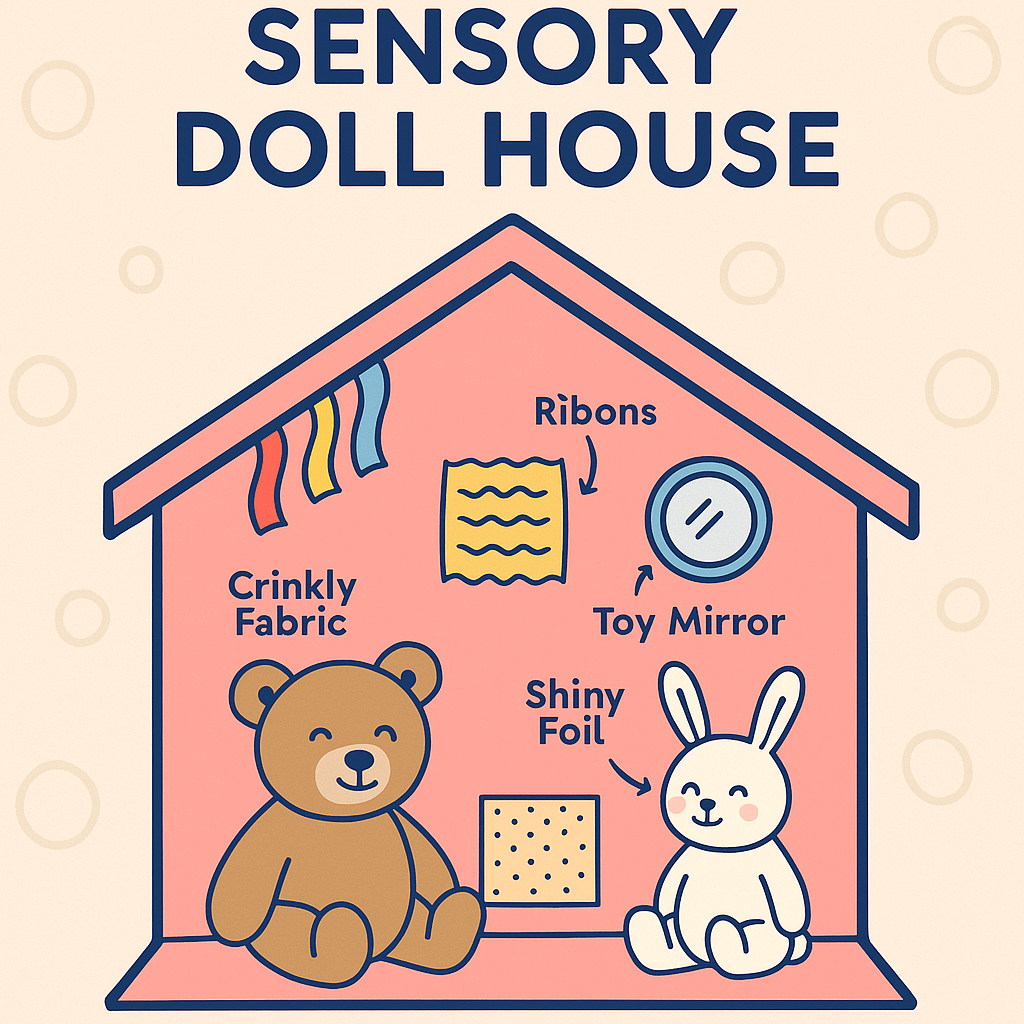
Transforming a simple cardboard box into a sensory doll house is one of the most creative and budget-friendly ways to support sensory development in babies.
👣 Try these sensory upgrades:
- Line the floor with a soft rice bag or bubble wrap for texture
- For visual stimulation, suspend old dupattas or ribbons from the ceiling.
- To capture the light, tape gleaming foil within a “window.”
- Add a small pouch of dry lentils or beads in a sock for sound
- Utilize unused Barbie playhouse toys to add features for imaginary play.
This DIY version turns a regular doll house into a safe, sensory-rich zone that babies can explore freely.
💡 The play grows together with your baby:
- 👶 Younger babies explore with their hands, feet, and mouths
- 👧 Older babies begin pretend play with dolls, animal figures, or soft blocks
✅ Bonus: Mix and match! Use parts from branded Barbie doll house sets and combine them with your own DIY sensory creations. You get the durability of store-bought toys and the charm of homemade love — all in one box.
🧘♀️ Sensory Play for Parents Too: The Rise of Fidget Toys
Who says sensory toys are only for babies?
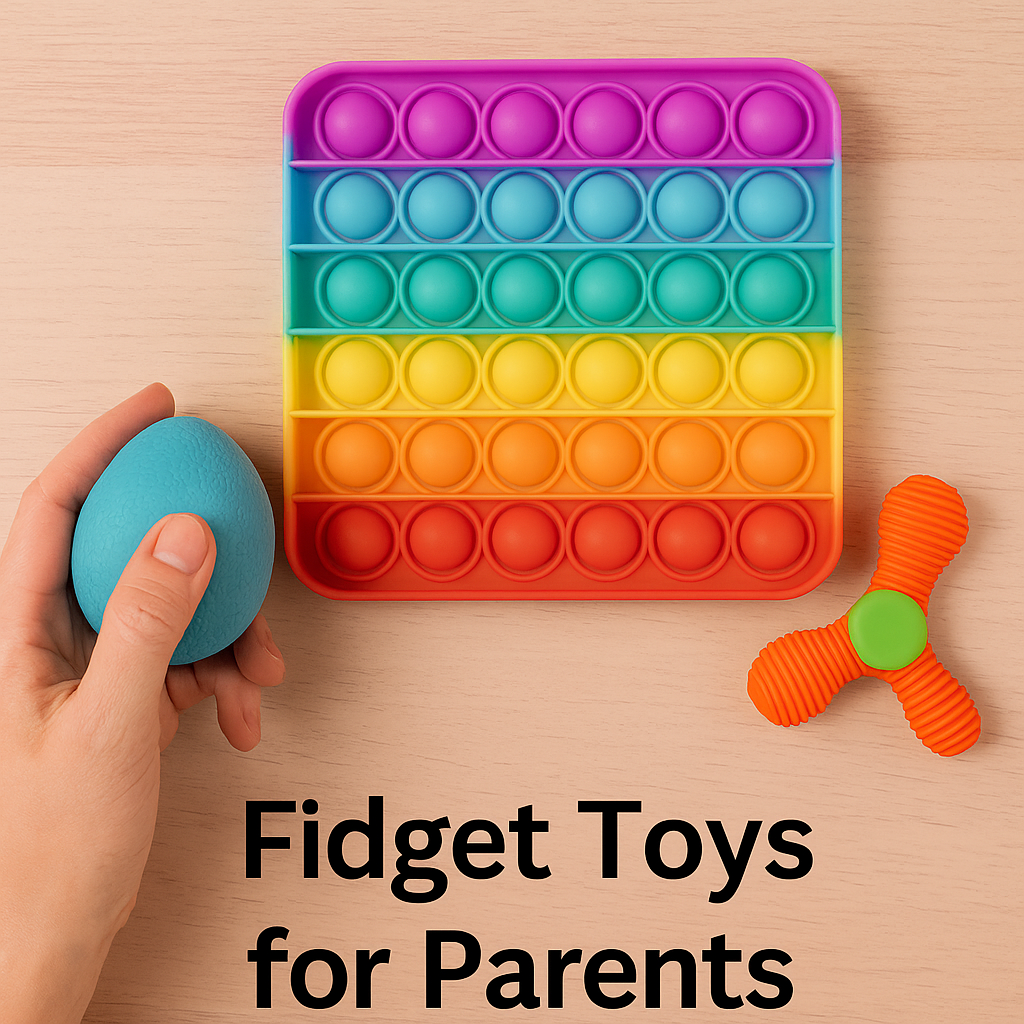
In today’s fast-paced parenting world, many Indian parents are turning to fidget toy adult tools to stay calm, present, and emotionally grounded while playing with their kids. These aren’t just gadgets — they’re tools to manage your own mental wellness.
🌟 Trending fidget tools for parents:
- Stress balls: Great for muscle relaxation and focus
- Pop-it pads: Satisfying and soothing under pressure
- Textured rings or spinners: Help with anxiety and fidgety hands
👪 Why this matters:
Using fidget toy adult tools during play not only supports your own regulation but models healthy behavior for your child. You’re teaching them that big feelings are okay — and manageable.
🔍 Keyword Insight: The surge in popularity for fidget autism toys shows that sensory tools benefit both neurodiverse and neurotypical individuals — across all age groups. They help reduce screen time, improve focus, and encourage mindful parenting.
🛠️ Quick Tips for DIY Sensory Toys Success
Before you go full DIY, keep these quick but crucial reminders in mind:
✅ Always supervise play sessions — even with soft or plush items
✅ Use food-safe, baby-safe materials — avoid small parts for under 12 months
✅ Store in breathable cloth bags — plastic traps moisture and germs
✅ Clean weekly — wipe down or wash fabric parts
✅ Rotate toys — novelty helps babies stay curious and engaged
🎯 A good rule: Less is more. Focus on 2–3 DIY items per week and observe what excites your baby most.
📊 Age-Wise Toy Rotation Chart (0–12 Months)
This chart helps you keep playtime fresh, focused, and age-appropriate — using both DIY and store-bought toys.
| Age Range | Sensory Focus | Toy Ideas |
| 0–3 Months | Visual & Auditory | Crinkle cloth, high-contrast cards |
| 3–6 Months | Touch & Movement | Play mat sensory, textured rattles |
| 6–9 Months | Cause & Effect | DIY tissue pull box, treasure basket |
| 9–12 Months | Pretend & Explore | Sensory doll house, shape sorters, plushies |
🔁 Depending on your baby’s development and level of interest, rotate every seven to ten days.
🛍️ When to Buy and When to DIY
Sometimes, buying a toy makes sense. Other times, a little creativity can go a long way — especially if you’re on a budget or want a more meaningful connection.
| Buy | DIY |
| Fidget toy adult | Sensory boards with zips, velcro, and beads |
| Barbie doll house | Reuse a shoebox with dolls, foil, and soft fabrics |
| Play mat sensory | Patchwork quilt with different textured fabrics |
| Plushie toys | DIY plushies with felt, buttons (for 12+ months) |
🧸 Not every toy has to come from a store. Many of the most memorable play moments come from things you built together — not what you bought.
🧩 Final Thoughts: DIY Sensory Toys Create More Than Just Play
In a world overflowing with flashy Barbie doll house ads, noisy light-up toys, and overpriced branded doll house kits, it’s easy to feel like “more” means “better.” But the truth is simpler — DIY sensory toys offer what money can’t always buy: creativity, bonding, and personal connection.
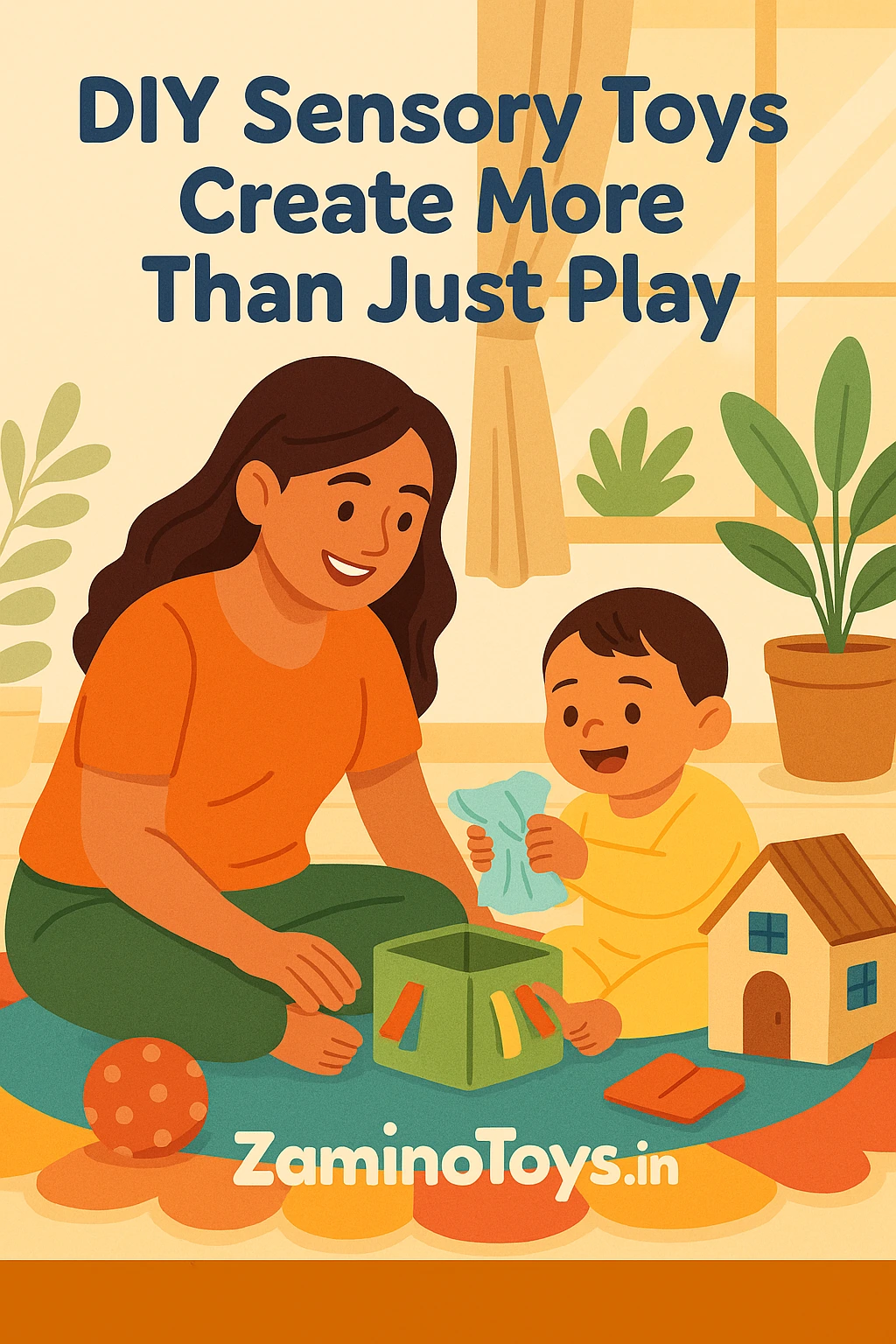
Homemade play doesn’t need to be complicated. No need for a fancy Pinterest setup or picture-perfect materials. A few old cloth scraps, a clean plastic bottle, soft textures, or even a cardboard box can become your baby’s favorite discovery tool. When your baby crinkles paper, explores cold spoons, or pulls ribbons from a tissue box — they’re not just playing, they’re learning.
These little moments fuel big brain development.
💡 DIY sensory toys give you full control over materials, safety, and purpose. You decide what your baby experiences — whether it’s the cool touch of stainless steel, the soft squish of a sponge, or the contrasting visuals of black and white shapes.There is no room for Harmful substances like Paint,Battery and also no over simulation.just simple actual world playing experience only.
What matters most is you — your voice, your encouragement, and the love you bring to every game and giggle.
✅ At ZaminoToys, we believe Indian parents don’t have to follow trends or fill rooms with plastic toys. Instead, create a few simple, purposeful items that support early development while honoring your values and budget.
DIY in DIY sensory toys isn’t just “do it yourself.” It’s do it with love.
So go ahead — repurpose that shoebox, sew that sock puppet, or weave a few ribbons into a sensory treasure.These toys not only just simple object but also its represents the beginning of memories and emotions.
📌 Bookmark this blog, and share it with new parents, grandparents, and caregivers who want to build better bonding — one toy at a time.
🔗 Related Reads for Who Inspired by Our “DIY sensory toys” Blog:
- 🎯 Age-Wise Toy Guide: Choose the Right Toy by Age
- 👶 Toys for 0–6 Months: Sensory & Brain Development
- 🚼 Best Toys for 6 to 12 Months: Montessori Play & More

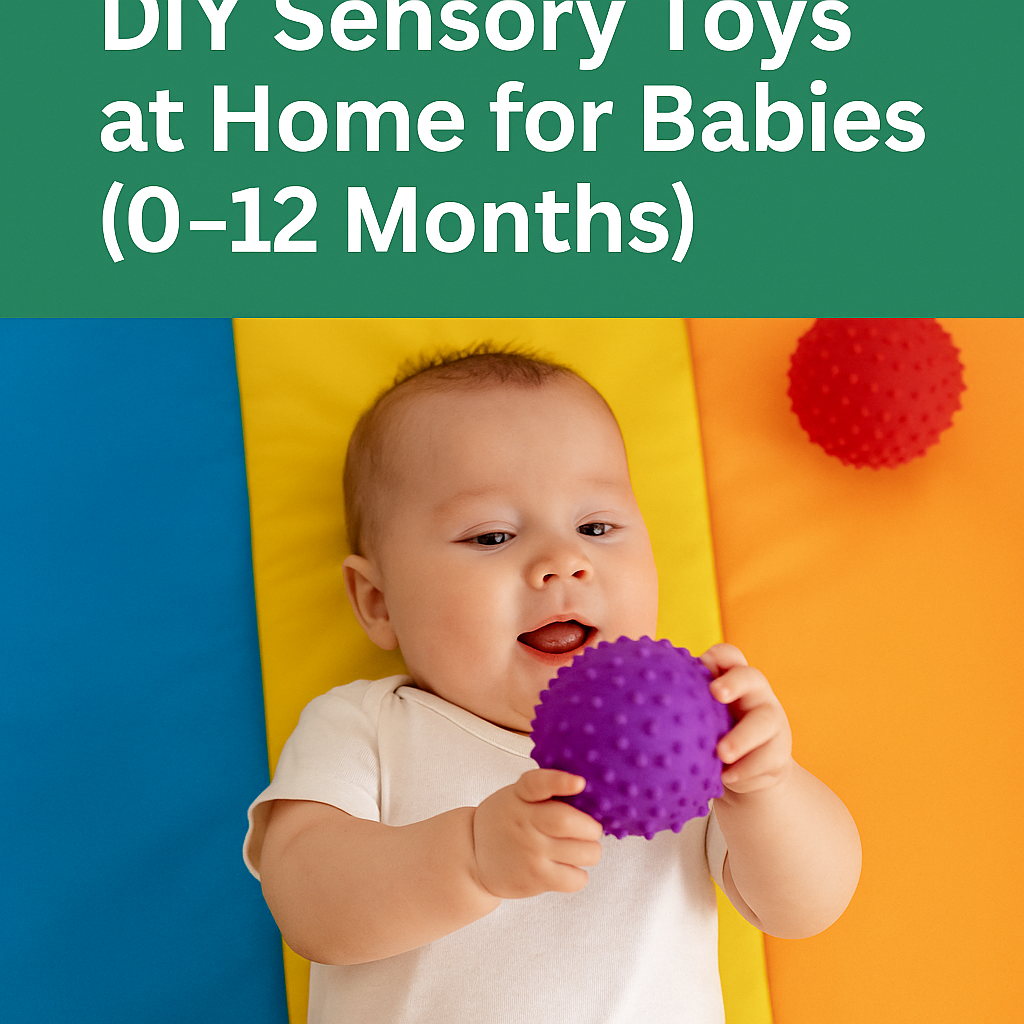
Pingback: 5 Gentle Parenting Tips That Work – Indian Parenting Advice
Pingback: 9 Best Musical Toys for Brain Development Backed by Science
Pingback: 10 Powerful Positive Parenting Tips for New Parents
Pingback: A Short Guide to Sensory Toys for Parents (Age-Wise Selections & Purchase Links) - zaminotoys